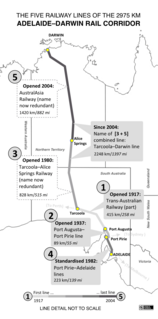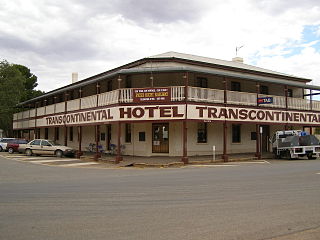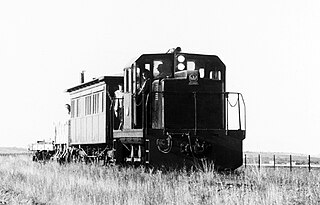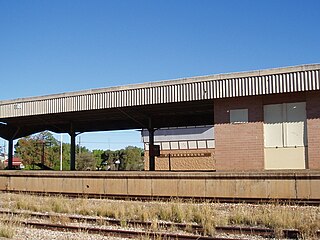
Port Augusta is a small city in South Australia. Formerly a seaport, it is now a road traffic and railway junction city mainly located on the east coast of the Spencer Gulf immediately south of the gulf's head and about 322 kilometres (200 mi) north of the state capital, Adelaide. The suburb of Port Augusta West is located on the west side of the gulf on the Eyre Peninsula. Other major industries included, up until the mid-2010s, electricity generation. At June 2018, the estimated urban population was 13,799, having declined at an average annual rate of -0.53% over the preceding five years.

The Ghan is an experiential tourism oriented passenger train service that operates between the northern and southern coasts of Australia, through the cities of Adelaide, Alice Springs and Darwin on the Adelaide–Darwin rail corridor. Operated by Journey Beyond Rail Expeditions, its scheduled travelling time, including extended stops for passengers to do off-train tours, is 53 hours 15 minutes to travel the 2,979 kilometres (1,851 mi). The Ghan has been described as one of the world's great passenger trains.

The Adelaide–Darwin rail corridor is a 2,975 kilometres (1,849 mi) series of south–north transcontinental railway lines in Australia, between the cities of Adelaide and Darwin. Built in stages in the twentieth century, the corridor was completed in 2004 when the Alice Springs to Darwin line opened. The corridor is used by The Ghan passenger train and freight trains operated by One Rail Australia.

Quorn is a small town and railhead in the Flinders Ranges in the north of South Australia, 39 kilometres (24 mi) northeast of Port Augusta. At the 2016 census, the locality had a population of 1,230, of which 1,131 lived in its town centre.

The Pichi Richi Railway Preservation Society (PRRPS) is a non-profit railway preservation society and operating museum formed in 1973. Managed and staffed by its volunteer members, it operates heritage steam and diesel trains on the restored 39 kilometre section of track between Quorn and Port Augusta in the southern Flinders Ranges of South Australia.

The former Central Australia Railway, which was built between 1878 and 1929 and closed in 1980, was a 1,241 km (771 mi) 1067 mm narrow gauge railway between Port Augusta and Alice Springs. A standard gauge line duplicated the southern section from Port Augusta to Maree in 1957 on a new nearby alignment. The entire Central Australia Railway was superseded in 1980 after the standard gauge Tarcoola–Alice Springs Railway was opened, using a new route up to 200 km to the west. A small southern section of the original line between Port Augusta and Quorn has been preserved as the Pichi Richi Tourist Railway.

The rail network in Adelaide, South Australia, consists of four lines and 89 stations, totalling 132 km. It is operated by Keolis Downer under contract from the Government of South Australia, and is part of the citywide Adelaide Metro public transport system.
Australians generally assumed in the 1850s that railways would be built by the private sector. Private companies built railways in the then colonies of Victoria, opened in 1854, and New South Wales, where the company was taken over by the government before completion in 1855, due to bankruptcy. South Australia's railways were government owned from the beginning, including a horse-drawn line opened in 1854 and a steam-powered line opened in 1856. In Victoria, the private railways were soon found not to be financially viable, and existing rail networks and their expansion were taken over by the colony. Government ownership also enabled railways to be built to promote development, even if not apparently viable in strictly financial terms. The railway systems spread from the colonial capitals, except in cases where geography dictated a choice of an alternate port.

The first railway in colonial South Australia was a line from the port of Goolwa on the River Murray to an ocean harbour at Port Elliot, which first operated in December 1853, before its completion in May 1854.

The Trans-Australian Railway, opened in 1917, runs from Port Augusta in South Australia to Kalgoorlie in Western Australia, crossing the Nullarbor Plain in the process. As the only rail freight corridor between Western Australia and the eastern states, the line is strategically important. The railway includes the world's longest section of completely straight track.

The Commonwealth Railways were established in 1917 by the Government of Australia with the Commonwealth Railways Act to administer the Trans-Australia and Port Augusta to Darwin railways. It was absorbed into Australian National in 1975.

The Commonwealth Railways NC class consisted of two diesel-hydraulic locomotives built by Clyde Engineering, Granville, New South Wales in 1956. The Lakewood Firewood Company, Kalgoorlie was the first owner; the Commonwealth Railways purchased them in 1965. They ceased revenue service in the early 1980s.

The Commonwealth Railways NSU class was a class of diesel-electric locomotives built in 1954 and 1955 by the Birmingham Railway Carriage and Wagon Company, England, for the Commonwealth Railways for use on the narrow-gauge Central Australia Railway and North Australia Railway.

The NT class were a class of diesel locomotives built by Tulloch Limited, Rhodes for Commonwealth Railways for use on the Central and North Australia Railways between 1965 and 1968.

Peterborough railway station is located on the Crystal Brook-Broken Hill line in Peterborough, South Australia.

Quorn railway station was located on the Central Australia Railway serving the South Australian town of Quorn.

Marree railway station was located on the Central Australia Railway serving the small South Australian outback town of Marree.
The Marree railway line is located in the Australian state of South Australia.

The NDH class railcar is a self propelled diesel-hydraulic railcar designed by Commonwealth Engineering and built by the Gloucester Railway Carriage & Wagon Company in England for the Commonwealth Railways, Australia in 1954. They were known as Gloucester railcars.

















